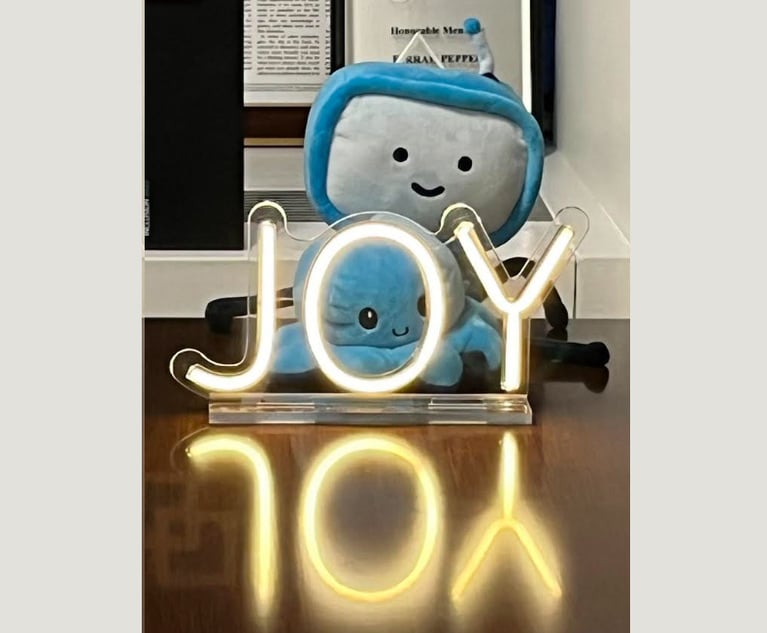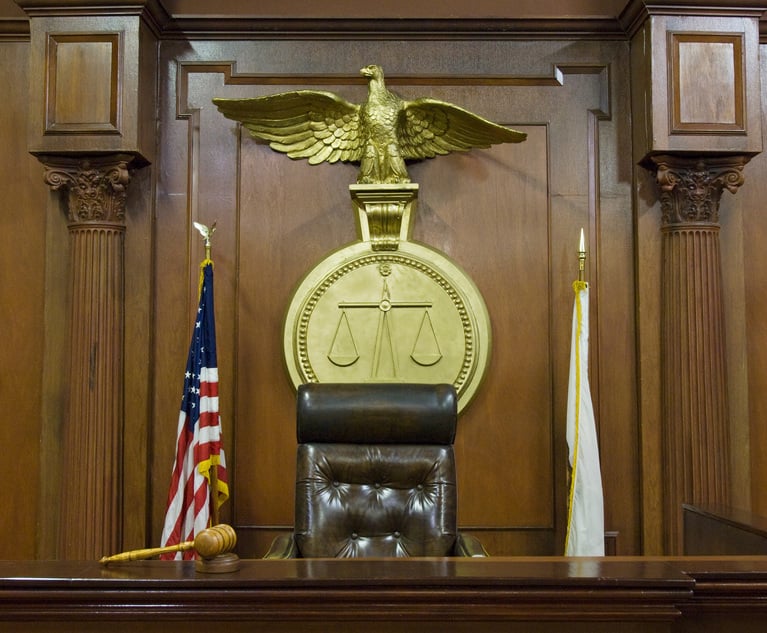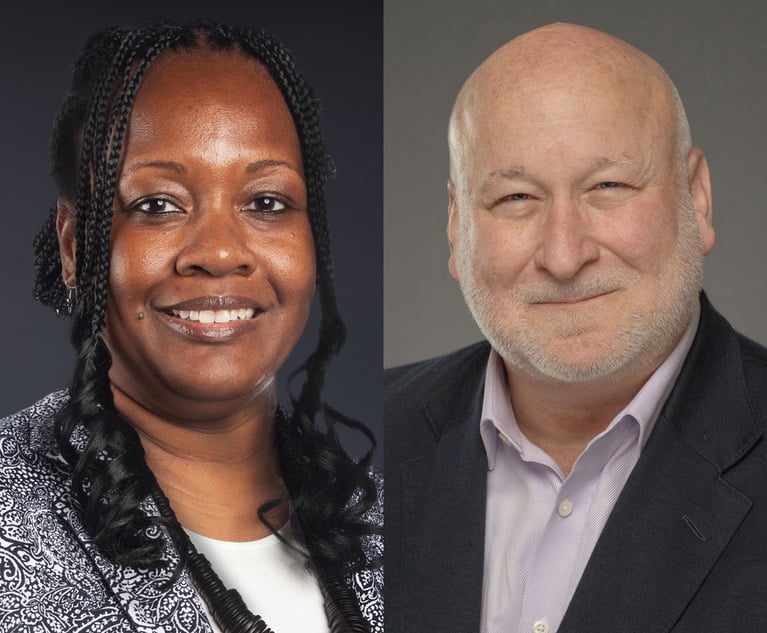Associational Discrimination Case Allowed to Proceed
The men's basketball team at Iona College in New Rochelle, N.Y., wasn't doing as well as it had in the past. Finding that the coaching ...
July 31, 2008 at 08:00 PM
15 minute read
The men's basketball team at Iona College in New Rochelle, N.Y., wasn't doing as well as it had in the past. Finding that the coaching staff was to blame, the school fired two of the four coaches.
Assistant Head Coach Craig Holcomb, a white man married to a black woman, was one of two people fired during the 2004 staffing shake up. The other fired employee was the only black assistant coach–Tony Chiles. The two coaches kept on the staff were white–Head Coach Jeff Ruland and Assistant Coach
Rob O'Driscoll.
Holcomb sued under Title VII, claiming associational discrimination. His suit states that Richard Petriccione, a vice president of the college, and Shawn Brennan, the director of athletics, put him on the chopping block because
his wife was black.
The District Court granted summary judgment in July 2006 to the defendants, finding that “even if Petriccione and Brennan had previously engaged in racist conduct, Holcomb had produced no evidence that his firing was the product of improper discriminatory motives.”
After all, Holcomb is white and not recognized as a member of a protected class under Title VII. But taking an expansive look at Title VII, Second Circuit Judge Guido Calabresi wrote, “We hold, for the first time, that an employer may violate Title VII if it takes action against an employee because of the employee's association with a person of another race.”
The ruling added that when an employee is subjected to adverse action because an employer disapproves of an interracial association, the employee suffers discrimination because of the employee's own race.
“This creates new law,” says Joe Kouri, a partner at Sedgwick, Detert, Moran & Arnold in San Francisco. “It says, in effect, that a white person married to a person of a different race can sue for race discrimination based on his own race.”
If Holcomb were black it wouldn't be an issue that he married a black woman because he would not be in an interracial relationship. “But for the fact that he is white, he wouldn't have been fired, and therefore it's his race that was the focal point,” Kouri says.
Discriminatory Evidence
Although Holcomb is not a member of a protected class himself, the 2nd Circuit applied an expansive reading to Title VII because of evidence that Petriccione made racial remarks about Holcomb's wife.
Holcomb, who joined the Iona Gaels men's basketball team in 1995, married Pamela Gauthier, a black woman, in 2000. According to Holcomb, whose claim is backed up by a third party, when Holcomb asked Petriccione if he received his wedding invitation, he responded, “You're really going to marry that Aunt Jemima?”
Other examples of racism included a decision by Brennan in 2003 to bar Holcomb's wife and Ruland's girlfriend, who was black, from basketball team social and fundraising activities. Holcomb says Brennan said it was because neither woman was an alumnus. Holcomb maintains the real reason was to decrease the number of black people at these events because Iona alumni are mostly white. Brennan denied he ever excluded the women from any events.
The college maintained the decision to fire Holcomb was not based on racial factors, but instead on the need to improve the basketball team's poor performance by upgrading the coaching staff. Even though Holcomb and the only black member of the coaching staff were fired, the college said one of the new coaches hired was black, and Ruland, one of the white coaches not fired, was dating a black woman.
The 2nd Circuit ruled that hiring a black coach could have been an action by the college to conceal its prior discrimination. Also, firing Ruland would have been too expensive an option given his current contract with the college.
Extended Application
The court said that while Holcomb showed little evidence that he was terminated solely because his wife was black, he only needs to prove that the decision was partly based on racial discrimination and the case should be allowed to go before a jury.
“This same logic can apply to other circumstances,” Kouri says. “I don't see why the logic of Holcomb could not equally apply to same-sex relationship situations. Why couldn't a woman employee involved in a relationship with another woman say her gender is an issue?”
Carla Rozycki, a partner at Jenner & Block in Chicago, agrees. Under this logic, a woman living with a woman who gets fired and thinks her same-sex relationship was a factor can sue her employer claiming gender discrimination. She would be claiming she would not have been fired if she lived with a man instead of living with a woman.
“This could perhaps provide a rationale to recognize sexual orientation claims under Title VII, which currently does not prevent discrimination against people because of their sexual orientation,” Rozycki adds.
The case points up the need for employers to consider whether they need to revise their discrimination policies and training to ensure that supervisors understand they can't treat employees differently based on the people with whom they associate.
“[The decision] reinforces the need for employers to be vigilant, to be sure their workplace remains free from discrimination and to maintain zero tolerance toward such attitudes or conduct, not just because it's against the law, but because it's bad business,” says Steve Steinfeld, partner at Winston & Strawn's New York office.
He says employers will now have to look for evidence in adverse employment decisions of whether the decision-maker has some sort of bias against the person being fired because of an interracial relationship. “If so, people will wonder if the decision was tainted,” he says.
The men's basketball team at Iona College in New Rochelle, N.Y., wasn't doing as well as it had in the past. Finding that the coaching staff was to blame, the school fired two of the four coaches.
Assistant Head Coach Craig Holcomb, a white man married to a black woman, was one of two people fired during the 2004 staffing shake up. The other fired employee was the only black assistant coach–Tony Chiles. The two coaches kept on the staff were white–Head Coach Jeff Ruland and Assistant Coach
Rob O'Driscoll.
Holcomb sued under Title VII, claiming associational discrimination. His suit states that Richard Petriccione, a vice president of the college, and Shawn Brennan, the director of athletics, put him on the chopping block because
his wife was black.
The District Court granted summary judgment in July 2006 to the defendants, finding that “even if Petriccione and Brennan had previously engaged in racist conduct, Holcomb had produced no evidence that his firing was the product of improper discriminatory motives.”
After all, Holcomb is white and not recognized as a member of a protected class under Title VII. But taking an expansive look at Title VII, Second Circuit Judge
The ruling added that when an employee is subjected to adverse action because an employer disapproves of an interracial association, the employee suffers discrimination because of the employee's own race.
“This creates new law,” says Joe Kouri, a partner at
If Holcomb were black it wouldn't be an issue that he married a black woman because he would not be in an interracial relationship. “But for the fact that he is white, he wouldn't have been fired, and therefore it's his race that was the focal point,” Kouri says.
Discriminatory Evidence
Although Holcomb is not a member of a protected class himself, the 2nd Circuit applied an expansive reading to Title VII because of evidence that Petriccione made racial remarks about Holcomb's wife.
Holcomb, who joined the Iona Gaels men's basketball team in 1995, married Pamela Gauthier, a black woman, in 2000. According to Holcomb, whose claim is backed up by a third party, when Holcomb asked Petriccione if he received his wedding invitation, he responded, “You're really going to marry that Aunt Jemima?”
Other examples of racism included a decision by Brennan in 2003 to bar Holcomb's wife and Ruland's girlfriend, who was black, from basketball team social and fundraising activities. Holcomb says Brennan said it was because neither woman was an alumnus. Holcomb maintains the real reason was to decrease the number of black people at these events because Iona alumni are mostly white. Brennan denied he ever excluded the women from any events.
The college maintained the decision to fire Holcomb was not based on racial factors, but instead on the need to improve the basketball team's poor performance by upgrading the coaching staff. Even though Holcomb and the only black member of the coaching staff were fired, the college said one of the new coaches hired was black, and Ruland, one of the white coaches not fired, was dating a black woman.
The 2nd Circuit ruled that hiring a black coach could have been an action by the college to conceal its prior discrimination. Also, firing Ruland would have been too expensive an option given his current contract with the college.
Extended Application
The court said that while Holcomb showed little evidence that he was terminated solely because his wife was black, he only needs to prove that the decision was partly based on racial discrimination and the case should be allowed to go before a jury.
“This same logic can apply to other circumstances,” Kouri says. “I don't see why the logic of Holcomb could not equally apply to same-sex relationship situations. Why couldn't a woman employee involved in a relationship with another woman say her gender is an issue?”
Carla Rozycki, a partner at
“This could perhaps provide a rationale to recognize sexual orientation claims under Title VII, which currently does not prevent discrimination against people because of their sexual orientation,” Rozycki adds.
The case points up the need for employers to consider whether they need to revise their discrimination policies and training to ensure that supervisors understand they can't treat employees differently based on the people with whom they associate.
“[The decision] reinforces the need for employers to be vigilant, to be sure their workplace remains free from discrimination and to maintain zero tolerance toward such attitudes or conduct, not just because it's against the law, but because it's bad business,” says Steve Steinfeld, partner at
He says employers will now have to look for evidence in adverse employment decisions of whether the decision-maker has some sort of bias against the person being fired because of an interracial relationship. “If so, people will wonder if the decision was tainted,” he says.
This content has been archived. It is available through our partners, LexisNexis® and Bloomberg Law.
To view this content, please continue to their sites.
Not a Lexis Subscriber?
Subscribe Now
Not a Bloomberg Law Subscriber?
Subscribe Now
NOT FOR REPRINT
© 2024 ALM Global, LLC, All Rights Reserved. Request academic re-use from www.copyright.com. All other uses, submit a request to [email protected]. For more information visit Asset & Logo Licensing.
You Might Like
View All
Elaine Darr Brings Transformation and Value to DHL's Business

How Marsh McLennan's Small But Mighty Legal Innovation Team Builds Solutions That Bring Joy

Democratic State AGs Revel in Role as Last Line of Defense Against Trump Agenda
7 minute readTrending Stories
- 1Judge Grants Special Counsel's Motion, Dismisses Criminal Case Against Trump Without Prejudice
- 2GEICO, Travelers to Pay NY $11.3M for Cybersecurity Breaches
- 3'Professional Misconduct': Maryland Supreme Court Disbars 86-Year-Old Attorney
- 4Capital Markets Partners Expect IPO Resurgence During Trump Administration
- 5Chief Assistant District Attorney and Litigator Shortlisted for Paulding County Judgeship
Who Got The Work
Michael G. Bongiorno, Andrew Scott Dulberg and Elizabeth E. Driscoll from Wilmer Cutler Pickering Hale and Dorr have stepped in to represent Symbotic Inc., an A.I.-enabled technology platform that focuses on increasing supply chain efficiency, and other defendants in a pending shareholder derivative lawsuit. The case, filed Oct. 2 in Massachusetts District Court by the Brown Law Firm on behalf of Stephen Austen, accuses certain officers and directors of misleading investors in regard to Symbotic's potential for margin growth by failing to disclose that the company was not equipped to timely deploy its systems or manage expenses through project delays. The case, assigned to U.S. District Judge Nathaniel M. Gorton, is 1:24-cv-12522, Austen v. Cohen et al.
Who Got The Work
Edmund Polubinski and Marie Killmond of Davis Polk & Wardwell have entered appearances for data platform software development company MongoDB and other defendants in a pending shareholder derivative lawsuit. The action, filed Oct. 7 in New York Southern District Court by the Brown Law Firm, accuses the company's directors and/or officers of falsely expressing confidence in the company’s restructuring of its sales incentive plan and downplaying the severity of decreases in its upfront commitments. The case is 1:24-cv-07594, Roy v. Ittycheria et al.
Who Got The Work
Amy O. Bruchs and Kurt F. Ellison of Michael Best & Friedrich have entered appearances for Epic Systems Corp. in a pending employment discrimination lawsuit. The suit was filed Sept. 7 in Wisconsin Western District Court by Levine Eisberner LLC and Siri & Glimstad on behalf of a project manager who claims that he was wrongfully terminated after applying for a religious exemption to the defendant's COVID-19 vaccine mandate. The case, assigned to U.S. Magistrate Judge Anita Marie Boor, is 3:24-cv-00630, Secker, Nathan v. Epic Systems Corporation.
Who Got The Work
David X. Sullivan, Thomas J. Finn and Gregory A. Hall from McCarter & English have entered appearances for Sunrun Installation Services in a pending civil rights lawsuit. The complaint was filed Sept. 4 in Connecticut District Court by attorney Robert M. Berke on behalf of former employee George Edward Steins, who was arrested and charged with employing an unregistered home improvement salesperson. The complaint alleges that had Sunrun informed the Connecticut Department of Consumer Protection that the plaintiff's employment had ended in 2017 and that he no longer held Sunrun's home improvement contractor license, he would not have been hit with charges, which were dismissed in May 2024. The case, assigned to U.S. District Judge Jeffrey A. Meyer, is 3:24-cv-01423, Steins v. Sunrun, Inc. et al.
Who Got The Work
Greenberg Traurig shareholder Joshua L. Raskin has entered an appearance for boohoo.com UK Ltd. in a pending patent infringement lawsuit. The suit, filed Sept. 3 in Texas Eastern District Court by Rozier Hardt McDonough on behalf of Alto Dynamics, asserts five patents related to an online shopping platform. The case, assigned to U.S. District Judge Rodney Gilstrap, is 2:24-cv-00719, Alto Dynamics, LLC v. boohoo.com UK Limited.
Featured Firms
Law Offices of Gary Martin Hays & Associates, P.C.
(470) 294-1674
Law Offices of Mark E. Salomone
(857) 444-6468
Smith & Hassler
(713) 739-1250







